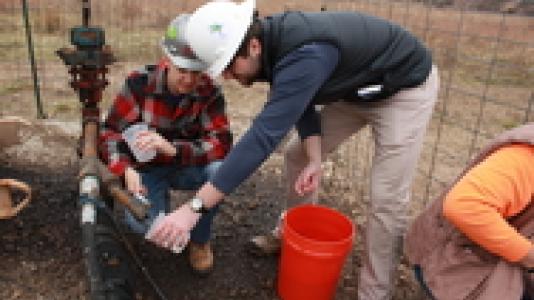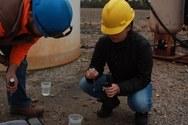
These small cells, measuring only 1/10,000th of an inch long, inhabit the space between mineral grains in these deep underground reservoirs and grow by converting buried organic matter to methane, the principal component of the natural gas we use to heat our homes and generate electricity. The environmental conditions which control the activity of these miniscule gas generators are poorly understood, however, limiting our ability to develop strategies that harness their energies to improve natural gas production.
A recent publication in Frontiers in Microbiology from Matthew Kirk, an assistant professor of geology at Kansas State University, and his colleagues at the University of North Carolina–Charlotte and Argonne National Laboratory, sheds new light on the role salinity plays in controlling the activity of methanogenic Archaea. Kirk and colleagues sampled methane-rich groundwater from commercial production wells that pump a mixture of gas and water from coal beds hundreds of feet beneath the surface of southern Kansas in a geological formation known as the Cherokee basin.
After using isotopic markers to determine that the gas coming from these wells was primarily of microbial origin, the authors examined the microbial cells they had filtered from the water by sequencing key genes from the microorganisms’ genomes. These genes, known as 16S ribosomal RNA (rRNA) genes, provide a taxonomic “fingerprint” that allows microbiologists to distinguish between different groups of microorganisms and tentatively identify each one’s primary method of metabolism. “By sequencing hundreds of thousands of these 16S rRNA genes from each sample, we can begin to construct a physiological profile of the overall microbial community in the Cherokee basin,” said Theodore Flynn, a microbial ecologist at Argonne who assisted with the project.
Kirk and his colleagues found that while most of the methane in the Cherokee basin wells came from hydrogen-utilizing methanogens, a substantial fraction came from acetate-utilizing methanogens. Contrary to expectations, the fraction of gas coming from acetate utilizers increased along with the salinity of the groundwater. Because commercial gas production can affect the salinity of groundwater, Kirk’s findings suggest that human activity has the potential to alter the pathway of methane formation in the subsurface and therefore affect our ability to recover natural gas from these important reservoirs.
PAPER: “Solute Concentrations Influence Microbial Methanogenesis in Coal-bearing Strata of the Cherokee Basin, USA”, by Kirk et. al. Front. Microbiol., 18 November 2015.
